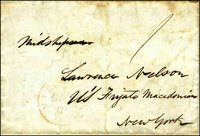MACEDONIAN
Ship Name and Designation History
This section lists the names and designations that the ship had during its lifetime. The list is in chronological order.
|
1836 - USF Macedonian
36-gun frigate was rebuilt from the keel of the first Macedonian at Gosport (later Norfolk) Navy Yard, Portsmouth, Va., beginning in 1832; and was launched and placed in service in 1836, Capt. Thomas ap C. Jones in command.
Macedonian was assigned to the West India Squadron to cruise in the West Indies and along the west coast of Africa from 1839 to 1847 as a continuing deterrent to Carribean pirates.
By a Joint Resolution of Congress 3 March 1847 Macedonian and sloop‑of‑war Jamestown were placed in civilian hands to carry food to Ireland during the famine of the late 1840’s. With a volunteer crew, Macedonian, Capt. George C. DeKay in command, departed New York 15 June with 12,000 barrels of provisions for Ireland donated by private citizens of the United States, returning to Brooklyn Navy Yard some months later to resume Navy service.
In 1852 Macedonian docked at the Brooklyn Navy Yard to be razed and converted to a sloop‑of‑war for the expedition to Japan, 1852 to 1854. Assigned to the East India Squadron under Commodore Matthew C. Perry, she, Capt. Joel Abbott in command, was one of the six American ships impressively arrayed off Uraga, Japan, 13 February 1854 during Perry’s second visit to negotiate the opening of Japan to foreign trade. The treaty signed at Yokohama 31 March 1854 was a distinctly naval feat in the diplomatic field. Commodore Perry had created such a show of force of firmness and of splendor on his initial visit at Kurihama 14 July 1853 that the isolationist Japanese began their remarkable turn to the West and westernization.
Macedonian remained on patrol in the North Pacific for the next 3 years. Then, from 1857 to 1861 she served with the Home Squadron in the Mediterranean and the Caribbean.
With the crisis of the Civil War looming just ahead, the sloop departed Portsmouth, N.H., for Pensacola, Fla., 12 January 1861 to join Brooklyn in preventing a possible Confederate attack on the harbor. On 11 February Macedonian sailed for Vera Cruz, Mexico, arriving the 24th. She then began patrol operations along the gulf coast and the coast of South America, with stops at Aspinwall (now Colon) and Porto Bello, Panama; Martinique, Windwards; and St. Thomas, Virgin Islands. On 3 December she got underway with Dacotah from St. Thomas for the east coast, arriving Boston Navy Yard 16 January 1862. Macedonian spent most of the next 2 years with the West India Squadron. In July 1863 she cruised along the coast of Portugal with sloop‑of‑war Kearsarge hunting CSS Southerner.
From the end of that year through 1870, Macedonian served as school and practice ship for midshipmen at the Naval Academy, first at Newport, Va., then after the Civil War at Annapolis, Md. In 1871 she was laid up in ordinary at the Norfolk Navy Yard, where she remained until 31 December 1875 when she was sold to Wiggin and Robinson for merchant service.
Ship information courtesy of DANFS
| Thumbnail Link To Cachet Close-Up Image | Thumbnail Link To Full Cover Front Image | Thumbnail Link To Postmark or Back Image | Primary Date Postmark Type Killer Bar Text --------- Cachet Category |
|---|
|
N/A |
 |
 |
1840-10-00 |
|
Personal letter |
The letter reads (as best I can read):
"Dear Lawry
Believing that you are mustered among the numbers of Macedonian's reefers, I drop you this line to say that you will find Mrs. I. and myself pleased to see you at our lodging no.37 Murray St.. When not better employed, you must drop in.
Yours truly
Edgar (unclear)
Midn Lawrence Nelson
US Frigate Macedonian
Oct (unclear), 1840
NOTE: A reefer is a short, blue coat formerly worn by middies & enlisted men. In days of sail it also meant the middies themselves (slang). It is also a modern term for a refrigerated storage place.
If you have images to add to this page, then either contact the Curator or edit this page yourself and add them. See Editing Ship Cover Pages for detailed information on editing this page.
Copyright 2025 Naval Cover Museum